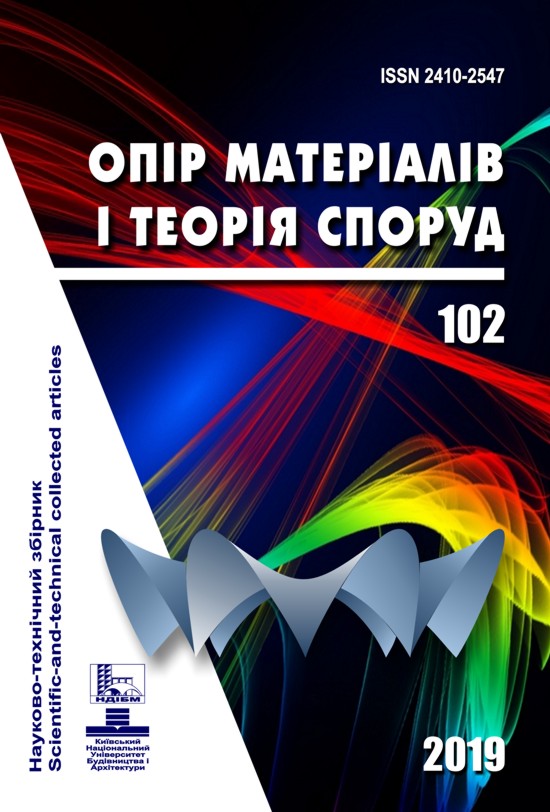Evaluation of the singular integrals of the three-dimensional thermoelasticity
DOI:
https://doi.org/10.32347/2410-2547.2019.102.220-231Keywords:
coupled thermoelasticity, boundary integral equations, fundamental solution, singularity, power seriesAbstract
The article deals with the solving of the problem of coupled thermoelastic vibrations of massive bodies. Numerical solution is sought by the boundary integral equation method. The main attention is paid to the definition of singular parts of integrals i.e. to integration along those boundary elements on which the pole is located. Two approaches are proposed for evaluation of singular integrals. The first approach is based on the expansion of integral equations kernels in a power series. For the realization of this approach, compact expressions approximating all components of the kernels are obtained. The obtained expressions has weak or strong singularities when the distance between the source point and integration point goes to zero similar to the behaviour of the corresponding elastostatic expressions. Therefore, such expressions can be successfully used for singular integrals evaluation. A number of numerical experiments have been performed, which confirms the robustness of the approach in a wide frequency range and allows us to trace the dependence between the number of retained members and the accuracy of the calculations. The second approach is related to the analytical calculation of integrals over a flat circle with a centre at the pole. In this paper the exact formulas were obtained that allow us to compute effectively the corresponding integrals over the boundary elements on which the pole is located. Among other things, the obtained exact expressions prove the existence of corresponding singular integrals in the sense of the Cauchy principal value. As a matter of a fact the above relations form the main part of a numerical algorithm aimed at solving the problem of coupled three-dimensional harmonic thermoelastic vibrations of massive elements of constructions using the of boundary element method.
References
Keramidas G.A., Ting E.C. A finite element formulation for thermal stress analysis. I. Variational formulation. II. Finite element formulation. Nucl Eng Des 1976;39:267–87.
Ting E.C., Chen H.C. A unified numerical approach for thermal stress waves. Comput Struct 1982;15:165–75.
Prevost J.H., Tao D. Finite element analysis of dynamic coupled thermoelasticity problem with relaxation times. J Appl Mech Trans ASME 1983;50:817–22.
Tamma K.K., Railkar S.B. On heat displacement based hybrid transfinite element formulations for uncoupled/coupled thermally induced stress wave propagation. Comput Struct 1988;30:1025–36.
Cannarozzi A.A., Ubertini F. A mixed variational method for linear coupled thermoelastic analysis. Int J Solids Struct 2001;38:717–39.
Sladek V., Sladek J. Boundary integral equation method in thermoelasticity. Part I: general analysis // Appl. Math. Modelling. – 1984. - No 7. – P. 241–253.
Shiah Y.C., Tan C.L. Exact boundary integral transformation of the thermoelastic domain integral in BEM for general 2D anisotropic elasticity. Comput Mech. 1999;23:87–96.
Park K.H., Banerjee P.K. Two- and three-dimensional transient thermoelastic analysis by BEM via particular integrals. Int J Solids Struct 2002;39:2871–92.
Kögl M., Gaul L. A dual reciprocity boundary element method for dynamic coupled anisotropic thermoelasticity. Southampton (UK): WIT Press; 2000.
Kögl M., Gaul L. A boundary element method for anisotropic coupled thermoelasticity. Arch Appl Mech 2003;73:377–98.
Gao X.-W., Zheng B.-J., Yang K., Zhang Ch. Radial integration BEM for dynamic coupled thermoelastic analysis under thermal shock loading. Computers and Structures 158 (2015) 140–147.
Tehrani P.H., Eslami M.R. Two-dimensional time-harmonic dynamic coupled thermoelasticity analysis by boundary element method formulation // Engineering Analysis with Boundary Elements. – 1998. – V. 22. - No 3, - P. 245-250.
Dargush G.F., Banergee P.K., Development of a boundary element method for time dependent planar thermoelasticity // Int. J. Solid Struct. – 1989. – No 25. - P. 999–1021.
Tosaka N., Suh I.G. Boundary element analysis of dynamic coupled thermoelasticity problems // Computational Mechanics. – 1991. V. 8. – P. 331-342.
Vorona Yu.V, Kara I.D. Zastosuvannya metodu granychnykh integralnykh rivnyan dlya rozv'yazannya dynamichnykh zadach termopruzhnosti (Application of boundary integral equations method for dynamic thermoelasticity problems) // Opir materialiv i teoriya sporud. – Vyp. 96. – K.: KNUBA, 2015. – S. 74-87. (ukr)
Trehmernye zadachi matematicheskoy teorii uprugosti i termouprugosti (Three-dimensional problems of mathematical theory of elasticity and thermoelasticity) / V.D.Kupradze, T.G.Hehelia, M.O.Basheleyshvili, G.V.Burchuladze, ed. V.D.Kupradze.; M: Mir, 1976. – 664 s. (rus)
Dominguez J. Boundary Elements in Dynamics. Computational Mechanics Publications, Southampton, 1993, 450 p.
Nowacki W. Dinamicheskiye zadachi termouprugosti (Dynamic problems of thermoelasticity). – M: Mir, 1970. – 256 s. (rus)
Roitfarb I.Z., Chu Viet Kyong. Chislennyi metod resheniya prostranstvennykh dinamycheskikh zadach teorii uprugosti na osnove metoda potensiala (Numerical technique for solving spatial elastodynamic problems with the help of the potential method) // Soprotivlenie materialov i teoriya sooruzheniy. – Vyp. 29. – K.: Budivelnyik, 1976. – S. 32-38. (rus)
Downloads
Published
Issue
Section
License
Authors retain copyright and grant the journal right of first publication with the work simultaneously licensed under a Creative Commons Attribution License that allows others to share the work with an acknowledgement of the work's authorship and initial publication in this journal.

